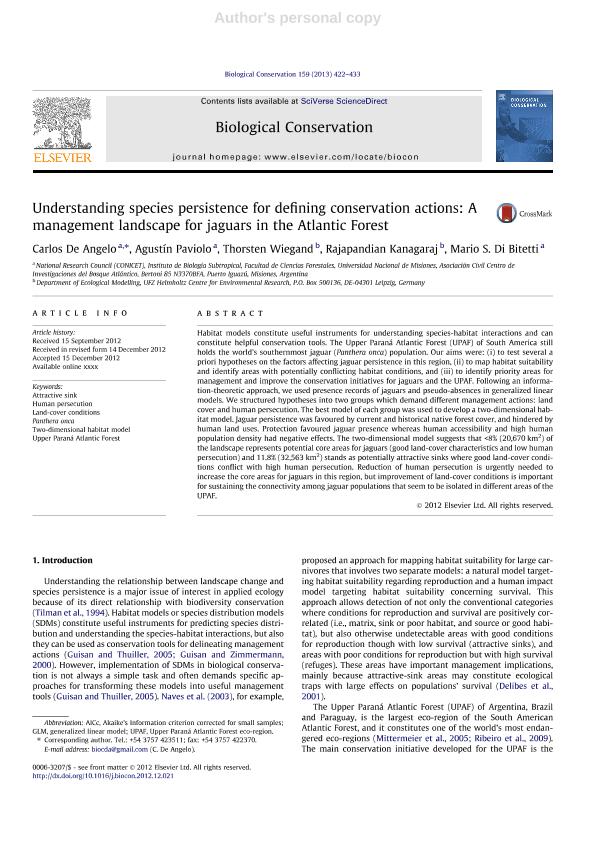Mostrar el registro sencillo del ítem
dc.contributor.author
de Angelo, Carlos Daniel

dc.contributor.author
Paviolo, Agustin Javier

dc.contributor.author
Wiegand, Thorsten
dc.contributor.author
Kanagaraj, Rajapandian
dc.contributor.author
Di Bitetti, Mario Santiago

dc.date.available
2017-11-30T17:20:30Z
dc.date.issued
2013-01
dc.identifier.citation
de Angelo, Carlos Daniel; Paviolo, Agustin Javier; Wiegand, Thorsten; Kanagaraj, Rajapandian; Di Bitetti, Mario Santiago; Understanding species persistence for defining conservation actions: A management landscape for jaguars in the Atlantic Forest; Elsevier; Biological Conservation; 159; 1-2013; 422-433
dc.identifier.issn
0006-3207
dc.identifier.uri
http://hdl.handle.net/11336/29345
dc.description.abstract
Habitat models constitute useful instruments for understanding species-habitat interactions and can constitute helpful conservation tools. The Upper Paraná Atlantic Forest (UPAF) of South America still holds the world’s southernmost jaguar (Panthera onca) population. Our aims were: (i) to test several a priori hypotheses on the factors affecting jaguar persistence in this region, (ii) to map habitat suitability and identify areas with potentially conflicting habitat conditions, and (iii) to identify priority areas for management and improve the conservation initiatives for jaguars and the UPAF. Following an information-theoretic approach, we used presence records of jaguars and pseudo-absences in generalized linear models. We structured hypotheses into two groups which demand different management actions: land cover and human persecution. The best model of each group was used to develop a two-dimensional habitat model. Jaguar persistence was favoured by current and historical native forest cover, and hindered by human land uses. Protection favoured jaguar presence whereas human accessibility and high human population density had negative effects. The two-dimensional model suggests that <8% (20,670 km2) of the landscape represents potential core areas for jaguars (good land-cover characteristics and low human persecution) and 11.8% (32,563 km2) stands as potentially attractive sinks where good land-cover conditions conflict with high human persecution. Reduction of human persecution is urgently needed to increase the core areas for jaguars in this region, but improvement of land-cover conditions is important for sustaining the connectivity among jaguar populations that seem to be isolated in different areas of the UPAF.
dc.format
application/pdf
dc.language.iso
eng
dc.publisher
Elsevier

dc.rights
info:eu-repo/semantics/openAccess
dc.rights.uri
https://creativecommons.org/licenses/by-nc-nd/2.5/ar/
dc.subject
Attractive Sink;
dc.subject
Human Persecution
dc.subject
Land-Cover Conditions
dc.subject
Panthera Onca
dc.subject
Two-Dimensional Habitat Model
dc.subject
Upper Paraná Atlantic Forest
dc.subject.classification
Otras Ciencias Biológicas

dc.subject.classification
Ciencias Biológicas

dc.subject.classification
CIENCIAS NATURALES Y EXACTAS

dc.title
Understanding species persistence for defining conservation actions: A management landscape for jaguars in the Atlantic Forest
dc.type
info:eu-repo/semantics/article
dc.type
info:ar-repo/semantics/artículo
dc.type
info:eu-repo/semantics/publishedVersion
dc.date.updated
2016-11-23T18:17:18Z
dc.journal.volume
159
dc.journal.pagination
422-433
dc.journal.pais
Países Bajos

dc.journal.ciudad
Amsterdam
dc.description.fil
Fil: de Angelo, Carlos Daniel. Centro de Investigaciones del Bosque Atlantico; Argentina. Consejo Nacional de Investigaciones Científicas y Técnicas. Centro Científico Tecnológico Conicet - Nordeste. Instituto de Biología Subtropical. Instituto de Biología Subtropical - Nodo Puerto Iguazú | Universidad Nacional de Misiones. Instituto de Biología Subtropical. Instituto de Biología Subtropical - Nodo Puerto Iguazú; Argentina
dc.description.fil
Fil: Paviolo, Agustin Javier. Centro de Investigaciones del Bosque Atlantico; Argentina. Consejo Nacional de Investigaciones Científicas y Técnicas. Centro Científico Tecnológico Conicet - Nordeste. Instituto de Biología Subtropical. Universidad Nacional de Misiones. Instituto de Biología Subtropical; Argentina
dc.description.fil
Fil: Wiegand, Thorsten. Helmholtz Centre for Environmental Research; Alemania
dc.description.fil
Fil: Kanagaraj, Rajapandian. Helmholtz Centre for Environmental Research; Alemania
dc.description.fil
Fil: Di Bitetti, Mario Santiago. Centro de Investigaciones del Bosque Atlantico; Argentina. Consejo Nacional de Investigaciones Científicas y Técnicas. Centro Científico Tecnológico Conicet - Nordeste. Instituto de Biología Subtropical. Instituto de Biología Subtropical - Nodo Puerto Iguazú | Universidad Nacional de Misiones. Instituto de Biología Subtropical. Instituto de Biología Subtropical - Nodo Puerto Iguazú; Argentina
dc.journal.title
Biological Conservation

dc.relation.alternativeid
info:eu-repo/semantics/altIdentifier/doi/http://dx.doi.org/10.1016/j.biocon.2012.12.021
dc.relation.alternativeid
info:eu-repo/semantics/altIdentifier/url/http://www.sciencedirect.com/science/article/pii/S0006320712005198
Archivos asociados
